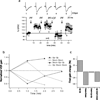Asymmetries in Cerebellar Plasticity and Motor Learning
- PMID: 25578035
- PMCID: PMC4500681
- DOI: 10.1007/s12311-014-0635-7
Asymmetries in Cerebellar Plasticity and Motor Learning
Abstract
Synaptic plasticity at the parallel fiber to Purkinje cell synapse has long been considered a cellular correlate for cerebellar motor learning. Functionally, long-term depression and long-term potentiation at these synapses seem to be the reverse of each other, with both pre- and post-synaptic expression occurring in both. However, different cerebellar motor learning paradigms have been shown to be asymmetric and not equally reversible. Here, we discuss the asymmetric reversibility shown in the vestibulo-ocular reflex and eyeblink conditioning and suggest that different cellular plasticity mechanisms might be recruited under different conditions leading to unequal reversibility.
Keywords: Cerebellum; Eyeblink conditioning; Motor learning; Purkinje cells; Synaptic plasticity; Vestibulo-ocular reflex.
Conflict of interest statement
The authors declare no conflict of interest.
Figures

Similar articles
-
Computational Theory Underlying Acute Vestibulo-ocular Reflex Motor Learning with Cerebellar Long-Term Depression and Long-Term Potentiation.Cerebellum. 2017 Aug;16(4):827-839. doi: 10.1007/s12311-017-0857-6. Cerebellum. 2017. PMID: 28444617
-
NMDARs in granule cells contribute to parallel fiber-Purkinje cell synaptic plasticity and motor learning.Proc Natl Acad Sci U S A. 2021 Sep 14;118(37):e2102635118. doi: 10.1073/pnas.2102635118. Proc Natl Acad Sci U S A. 2021. PMID: 34507990 Free PMC article.
-
T-type channel blockade impairs long-term potentiation at the parallel fiber-Purkinje cell synapse and cerebellar learning.Proc Natl Acad Sci U S A. 2013 Dec 10;110(50):20302-7. doi: 10.1073/pnas.1311686110. Epub 2013 Nov 25. Proc Natl Acad Sci U S A. 2013. PMID: 24277825 Free PMC article.
-
[Cerebellar synaptic plasticity and motor learning].Tanpakushitsu Kakusan Koso. 2008 Mar;53(4 Suppl):549-54. Tanpakushitsu Kakusan Koso. 2008. PMID: 21089335 Review. Japanese. No abstract available.
-
Synaptic memories upside down: bidirectional plasticity at cerebellar parallel fiber-Purkinje cell synapses.Neuron. 2006 Oct 19;52(2):227-38. doi: 10.1016/j.neuron.2006.09.032. Neuron. 2006. PMID: 17046686 Review.
Cited by
-
Effect of a differential training paradigm with varying frequencies and amplitudes on adaptation of vestibulo-ocular reflex in mice.Exp Brain Res. 2023 May;241(5):1299-1308. doi: 10.1007/s00221-023-06601-0. Epub 2023 Mar 31. Exp Brain Res. 2023. PMID: 37000203
-
Mechanisms underlying vestibulo-cerebellar motor learning in mice depend on movement direction.J Physiol. 2017 Aug 1;595(15):5301-5326. doi: 10.1113/JP274346. Epub 2017 Jul 10. J Physiol. 2017. PMID: 28586131 Free PMC article.
-
Plasticity leading to cerebellum-dependent learning: two different regions, two different types.Pflugers Arch. 2019 Jul;471(7):927-934. doi: 10.1007/s00424-019-02282-3. Epub 2019 May 19. Pflugers Arch. 2019. PMID: 31104128 Review.
-
Expression of a Form of Cerebellar Motor Memory Requires Learned Alterations to the Activity of Inhibitory Molecular Layer Interneurons.J Neurosci. 2023 Jan 25;43(4):601-612. doi: 10.1523/JNEUROSCI.0731-22.2022. Epub 2022 Dec 9. J Neurosci. 2023. PMID: 36639897 Free PMC article.
-
Impact of parallel fiber to Purkinje cell long-term depression is unmasked in absence of inhibitory input.Sci Adv. 2018 Oct 3;4(10):eaas9426. doi: 10.1126/sciadv.aas9426. eCollection 2018 Oct. Sci Adv. 2018. PMID: 30306129 Free PMC article.
References
-
- Albus JS. A Theory of cerebellar function. Math Biosci. 1971;10:25–61.
-
- Ito M. Cerebellar control of the vestibulo-ocular reflex - around the flocculus hypothesis. Annu Rev Neurosci. 1982;5:275–296. - PubMed
-
- Ito M, Kawai N, Udo M, Sato N. Cerebellar-evoked disinhibition in dorsal Deiters neurones. Exp brain Res. 1968;6:247–264. - PubMed
-
- De Zeeuw CI, Hansel C, Bian F, Koekkoek SKE, van Alphen AM, Linden DJ, Oberdick J. Expression of a protein kinase C inhibitor in Purkinje cells blocks cerebellar LTD and adaptation of the vestibulo-ocular reflex. Neuron. 1998;20:495–508. - PubMed
Publication types
MeSH terms
Grants and funding
LinkOut - more resources
Full Text Sources
Other Literature Sources

